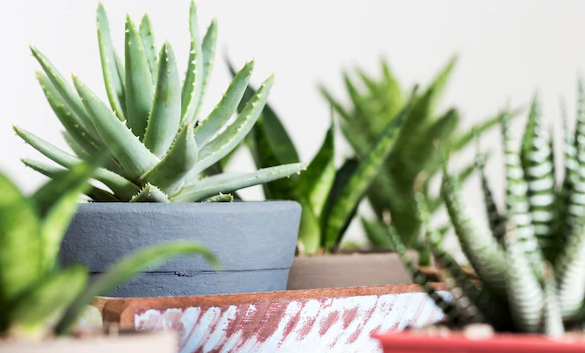Aloe Brevifolia can also be grown for ornamental purposes in rockeries and desert gardens all around the globe.
The Aloe Brevifolia, a small and discreet plant, is less than one foot tall. The thick, triangular, succulent-like leaves are reminiscent of aloe plants (hence the name!).
It is a glaucous, gray, and blue-green color, offering a distinct succulent appeal. The short-leaved aloe vera is great for tiny spaces, but still visually striking in pots or gardens.
So what do you need to know about this plant before adopting?
Here are some key Aloe Brevifolia facts to get started…
How to Identify Aloe Brevifolia

Aloe brevifolia is less than one foot tall.
The leaves are thick and triangular like aloe plants, but it grows in a succulent-like roset. It is glaucous, gray, and blue in color. The short-leaved aloe vera is great for tiny spaces, but still imposing in pots or gardens.
Hint: Look for the rose hues with gray and blue tones.
Where Does Aloe Brevifolia Grow
Aloe Brevifolia grows in the wild exclusively in South Africa and specifically in the Ruens Shale Renosterveld area.
This area is known for it’s distinct dry clay soil and sloping terrain, which present the ideal growing conditions for this variety. As such, it’s on the list of endangered plant varieties in the wild, as the already limited natural habitat is under pressure.
As long as you can mimic the sandy, dry clay climate, Aloe Brevifolia can theoretically grow elsewhere. Because the leaves contain (and retain) significant moisture, watering is only infrequently required (whether natural or by watering manually), if at all.
Aloe Brevifolia Uses
The Aloe Brevifolia is best used as a decorative plant, either indoors or for landscaping rock gardens, or as draught resistant ground cover.
Aloe Brevifolia itself is mildly toxic, so you should never consume or ingest. If this does occur, contact 911, poison control, or your local medical emergency hotline as soon as possible.
Is Aloe Brevifolia Safe for Pets?
No, it’s mildly toxic to dogs, cats and other pets, just like it is for humans. The spikey exterior creates a natural disincentive for pets, but if you suspect your pet has ingested Aloe Brevifolia, it’s best to contact your local veterinarian.
How to Grow Aloe Brevifolia From Seed
So you are ready to grow. Excellent! Let’s go over some of the core principles to successfully propagate Aloe Brevifolia from seed.
Note, these works for both purchased seeds and harvested seeds (assumed seeds were harvested correctly).
Aloe Brevifolia Growing Conditions
These aloe seeds grow quite easily IF the proper soil conditions are present. I recommend starting with a soil mixture of about 50% of peat and sand (note: make sure it’s true horticultural sand). Another substitute if you can’t find horticultural sand is mixing generic sand and small pebbles (for drainage) with the peat.
The ideal sunlight mixture for Aloe Brevifolia is a full sunlight. A good rule of thumb is at least 6 hours per day.
Pro Tip: Want to know if your Brevifolia is getting enough sun? In ideal conditions the edges of the leaves tint to an pink and orange hue.
Ideal growing temperatures for the Aloe Brevifolia are on the warmer side, ranging from 70 to 85 degrees Fahrenheit (21-28 Celsius). If growing outside, these plants can survive some frosts and light freezes down to 20 degrees (-7 Celsius), but only for limited duration (e.g. overnight or less than 48 hours). For Northern climates where freezing is a regular event, bring these aloe plants inside.
When to Plant Aloe Brevifolia
As discussed earlier, the growing conditions really dictate when you should plant this succulent.
As a rough rule of thumb, Aloe Brevifolia can be grown in the USDA growing zones 8 thru 11 range.
Within zones 8 thru 11, ideal planting conditions are likely in the Spring to give enough time to fully develop and (if outside) become hardy enough for the light frosts, particularly in the lower zones on this range (8a, 8b). For the higher zones, you can plant almost any time of the year.
How to Plant Aloe Brevifolia
The best way to plant Aloe Brevifolia depends a bit on how you are propagating.
You can also propagate your crocodile plant from its offsets. Isolate an offset and cut it from the plant. Let the wound dry out for a few days and then plant it. Keep the soil consistently moist until the cutting has grown roots and is established.
- If your host Aloe brevifolia has what are called rosettes (like it sounds, little rose-like hubs), then you can remove this portion (cutting or snipping). In order to let the cut area heal, do not water for the first few days in order to facilitate healing.
- If your host Aloe has what are called offsets (what looks like a little “child” or “pup” plant growing in the shadow of mom), then you can similarly cut it away from the main plant. Let it dry fully for a 2-3 days, then keep the soil moist while the new roots take hold.
If you are growing from a shoot (transplanting), the key consideration is soil condition. As discussed in growing conditions, ensure the soil is a dry soil and mixture. Also ensure there is proper drainage e.g. such that water won’t sit in and around the new plant.
Note: you do not need to immediately water the new Aloe Brevifolia like you would with other plants (see more on water requirements in the next section).
Aloe Brevifolia Water Requirements
Aloe Brevifolia succulents are desert natives and tend to require less regular watering. Rather, the best practice for Aloe Brevifolia is to get a good, thorough, but infrequent soaking about once every 10-12 days.
This is effectively to mimic desert conditions where rain is infrequent, but sudden and drenching. Aloe Brevifolia was built for this!
Over watering with frequent watering’s is actually a serious concern for Aloe Brevifolia as it can lead to soil rot. Ensure your Aloe Brevifolia is never sitting in standing water for more than a few hours. If the soil isn’t fully dry, it’s typically not ready to be watered yet.
Side Note: In winter you can get away with watering every 2-3 weeks, also mimicking desert conditions.
Aloe Brevifolia Sun Requirements
Aloe Brevifolia thrives in full sun environments. Partial shade can work too, just ensure ample direct sunlight for at least 50% of the daylight hours (or 6-8 hours as a rule of thumb)
This doesn’t mean it can’t grow in partial sun areas, just that it might not grow to it’s full potential.
A key consideration often missed is that Aloe Brevifolia can be sensitive to changes in sunlight. So, if you need to move from full sun to partial or partial to full sun, consider a gradual process. The ideal solution might be a 3/4 sun step for a few weeks,
If planting Aloe Brevifolia indoors, consider a location near windows with southern exposure.
Best Aloe Brevifolia Fertilizer
While not required for every planting, Aloe Brevifolia can benefit from a good balanced liquid succulent fertilizer.
I’d recommend using something like the Grow More mix (good for cactus + succulents), but dilute 25% with water before gently pouring immediately around the the Aloe Brevifolia root base.
Almost any liquid food fertilizer should work, as long as it’s purpose made for succulents. Something like Miracle-Gro Succulent Plant Food will also do (just similarly diluted with 25% water ratio).
The recommended feeding cycle is 2-3 times per year, with the exception of the Summer “dormant” season for this succulent. My personal calendar reminded is mid Fall, early January, and mid April. Even just 2 times (Fall and Spring) will do.
Best Aloe Brevifolia Companion Plantings
Aloe Brevifolia DOES have some nice options for companion plantings. In fact, pairing it up with some other plants that can perfectly complement its beauty!
What makes a great companion plant for aloe? Similar climates, soil types, nutrients, shade requirements AND attracting similar beneficial insects while repelling harmful insects.
Some plants just DO WELL together, as well, and the reasons aren’t always clear.
Euphorbia Tirucalli, also known as the pencil cactus is one to add to your list. It’s one of the best companion plantings for our crocodile aloe.
Sedum Rubrotinctum and Kalanchoe Luciae are also great options, and guess what? They have similar care needs, so it’s like they were meant to be planted together.
If you are looking for Aloe Brevifolia companion plantings OUTSIDE of succulents, consider these options as good companion plantings (that do well in similar habitats):
- Herbs: Chamomile, Tarragon, Organo, Chives.
- Vegetables: Onions.
- Flowers: Ederberry, Marigolds
Aloe Brevifolia Diseases and Common Problems
Like all Aloe varieties, Brevifolia does have some blights and common issues to be aware of.
- Root Rot: This is generally caused by overwatering or soil that holds excess water (typically a bad drainage issue).
- Aloe Rust: This literally appears as scabby rust like lesions, caused by fungal infections (specifically P. Meibomiae and Phakopsora Pachyfhiza).
- Leaf Spot: A variety of fungal infections can develop, typically manifesting as discolored spots on the leaves.
- Insect Infestations: A particular threat here are mealybugs and spider mites, generally causing wilting or yellowing leaves.
Aloe Brevifolia Treatments and Maintenance
So what are the optimal Aloe Brevifolia maintenance and treatments to prevent these common problems?
- Potting Mix that Drains Well: Drainage isn’t just how the aloe sits in the pot or garden, the soil type itself can determine how water is retained or filtered. This is perhaps THE most critical care and maintenance requirements. Good potting soil is generally labeled as specifically for succulents or cacti and generally is gritty. A homespun solution is adding sand or pumice to generic potting soil.
- Limit Fertilization: For this variety of aloe, there’s such a thing as “too much” fertilization. Never add fertilizer in Winter, and if you do want to boost growth in Spring/Summer, apply monthly with a balanced fertilizer reduced by 50% strength. Otherwise, just find a fertilizer specifically for cacti or succulents (often easier).
- Get Rid of Aloe Fungi: At the first sign of “aloe rust” mix a solution of 1 quart water, 1 teaspoon baking soda and gently spray the affected areas as needed (ensure you spray underneath the stems as well).
- Get Rid of Aloe Mealybugs or Insects: For mealybugs (and most other insect issues) mix 1 quart water with rubbing alcohol and spray the entire plant (not just where you see the bugs). For extra potency, add a few drops of dish soap (Dawn or equivalent brand).
Aloe Brevifolia Repotting Instructions
If you are looking to transfer or repot Aloe Brevifolia, here’s what you should do:
- Before you start repotting your Aloe Brevifolia, you need to make sure that the soil is dry. Wet soil can make it difficult to remove the plant, and it can also cause damage to the roots.
- Once you’ve confirmed that the soil is dry, gently remove the plant from its pot. If the plant is too big, you may need to use a knife or scissors to cut the pot.
- After removing the plant, gently remove any excess soil from the roots. You can use your fingers or a small brush to do this. Make sure not to damage the roots in the process.
- If you notice any damaged or dead roots, remove them with a sharp, sterile knife.
- Once the roots are clean, it’s time to repot your Aloe Brevifolia. Choose a pot that’s slightly larger than the previous one. The new pot should have drainage holes to prevent the soil from becoming waterlogged.
- Fill the pot with a well-draining soil mixture, such as a cactus or succulent mix.
- Place the Aloe Brevifolia in the new pot and fill the sides with soil. Make sure to leave some space at the top to avoid overwatering.
- Gently tap the pot to settle the soil and remove any air pockets.
- Water the plant lightly and let it settle in its new home for a few days before resuming regular care.
Where to Buy Aloe Brevifolia Seeds Online
If you are feeling adventurous and up to the task of cultivating Aloe Brevifolia from seed, consider these quality seed sellers:
- Amazon.com: I’ve had good success ordering from this listing here. There’s not much background on the seller, but can’t complain about the results!
- SeedsWorld.online: This is a good option if you are ordering in bulk (15+ seeds), as it can be slightly cheaper than Amazon. I’ve also used this vendor for other succulent seeds and have no complaints.
Where to Buy Aloe Brevifolia Plants Online
If you are looking for grown Aloe Brevifolia that you just need to maintain and nurture, check my favorite retailers (specifically for this variety) here:
- Planet Desert: I’m a big fan of Planet Desert because they have a great rewards program here. Their orders always arrive in great shape and they are generally in stock of the Aloe Brevifolia here.
- Leaf & Clay: I absolutely love their customer service, so it’s one of the first places I check for succulents. They carry Aloe Brevifolia here in both the 3″ and 4″ variety. Usually arrives within 1 week of ordering, in my experience.
- Mountain Crest Gardens: A nice family run operation, available by phone if you have questions (very knowledgeable staff). They are quite affordable at just $3.99 per aloe brevifolia here. They offer free shipping on orders $45 and over, so I typically order in batches or when I need 6-10+ succulents. They only ship on Monday’s and Tuesday’s, so it may take up to 10 days (a bit longer than Leaf & Clay in my experience).
- The Succulent Source: They have an interesting option where you can either order a large 1 gallon plant for $35 or a small cutting for $4 here. Generally the 1 gallon bucket is a great option if you plan on individually propagating and cutting yourself. Just note that what you are getting isn’t “office window ready” as it’s the raw plant and may need some trimming and can come with a few brown ends.
- Amazon: Amazon can be VERY hit or miss when ordering succulents (packaging standards vary), but this listing here is sold via Succulents Box a vendor I trust that sells independently, too. Not the cheapest option, but ships relatively fast & has all the typical Amazon convenience factors.
- Aloe Brevifolia (Short-Leaved Aloe) Guide - April 28, 2022

